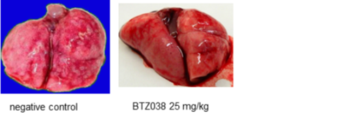Novel Benzothiazinones, potent Tuberculosis antibiotics
Challenge
WHO estimates that tuberculosis (TB) infects one third of the world’s population. Although people infected with TB will not necessarily become sick with the disease, because the TB bacilli can be "walled off" by a thick waxy coat and lie dormant for years, the chances of becoming sick are higher when the immune system is weakened. Although the estimated number of people falling ill with TB each year is declining slowly, in 2011 still 8.7 million people fell ill and an estimated 1.4 million people died from TB, including 430.000 HIV-positive patients. Although there are powerful anti-TB drugs like rifampicin and isoniazid available, after decades of use resistant pathogens have emerged, particularly MDR-TB and even XDR-TB that are insensitive not only to the first line but also to second line antibiotics. Therefore the demand for innovative antibiotics, particularly those addressing new targets, remains high.
Technology
Newly developed Benzothiazinones (BTZs), a new class of antibacterial compounds, show selective antibiotic activity against mycobacteria. The minimal inhibition concentration (MIC) of a variety of BTZs against different mycobacteria is very low, ranging from 1 ng/ml against M. tuberculosis and 4 ng/ml against M. smegmatis for the most advanced molecule BTZ043, which compares favorably with the gold standards isoniazid and ethambutol. BTZ043 displays similar activity against a broad spectrum of clinical isolates of M. tuberculosis, including multidrug-resistant and extensively drug-resistant strains. As molecular target the bacterial enzyme decaprenylphosphoryl-β-D-ribose-2’-epimerase could be identified, a key enzyme for the synthesis of cell wall arabinans. Furthermore, proof-of-concept in a mouse infection model could be demonstrated. BTZ043 shows low toxicity with acute (5g/kg) and chronic doses (250mg/kg) that showed no adverse effects after one month, even when the highest doses were applied. To conclude, the chemical synthesis of BTZ043 is ready to be upscaled to industrial requirements.
Commercial Opportunity
The technology is offered for in-licensing.
Patent Situation
A comprehensive worldwide portfolio of granted patents and pending patent applications was built to cover a broad spectrum of BTZ structures based on WO2007134625 and WO2009010163.
Further Reading
Makarov et al. 2009. Science, 324, 801-804
Lechartier et al. 2012. Antimicrob. Agents Chemother., 56, 5790-5793
Pasca et al. 2012. Antimic. Agents Chemother. 54, 1616-1618





